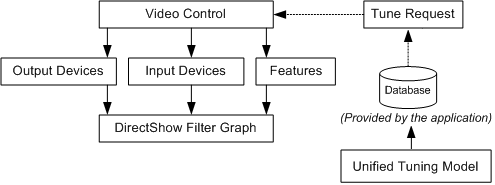
| Microsoft DirectX 9.0 |
The most important concepts in Microsoft® TV Technologies are the Video Control and the Microsoft Unified Tuning Model. Both are shown in the following illustration.

The Video Control is an ActiveX® control that handles television tuning, DVD and file playback, and stream buffering. The Video Control can be hosted in any ActiveX container, including Visual Basic® forms, Web pages running in Microsoft® Internet Explorer, or even Microsoft PowerPoint® presentations. For the first time, you can write advanced television applications using Visual Basic or script languages.
Note The Video Control is available in Windows XP only. For applications intended to run on Windows 98SE, Windows 2000, and Windows Millennium Edition, see Writing Digital TV Applications with DirectX.
Internally, the Video Control creates a DirectShow filter graph. It also creates various helper components that manage the filter graph. These components are grouped into three categories:
Devices and features provide the application with a higher level of abstraction than the underlying DirectShow filters. They give you a consistent set of interfaces for controlling DirectShow, organized around functionality rather than the internal implementation. For more information about using the Video Control, see Using the Video Control.
The Unified Tuning Model is an API that defines tuning on any type of network, using any kind of compatible device. Microsoft TV Technologies includes software components that implement the Unified Tuning Model for several network types, including ATSC and Digital Cable. Third parties can implement the Unified Tuning Model for other network types. By using the tuning model to perform tuning, an application will automatically support any new network types that may be introduced in the future, either by Microsoft or by third parties.
From the application's standpoint, the main object in the Unified Tuning Model is the tune request. A tune request contains all the information that the Video Control needs to tune to a particular broadcast service. Tune requests are typically created by a separate component, called a guide store loader, and then stored in a database. The application performs tuning by getting a tune request from the database and submitting it to the Video Control. For more information, see The Microsoft Unified Tuning Model.